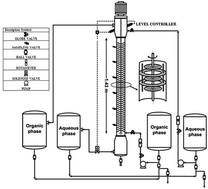Hold-up and flooding characteristics in a perforated rotating disc contactor (PRDC)
Abstract
Dispersed phase hold-up and flooding behavior were investigated in a pilot plant scale perforated rotating disc contactor (PRDC) using three different liquid–liquid systems. The influence of various operational parameters including rotor speed, continuous and dispersed phases flow rates on flooding velocities and hold-up have been studied. Changes in the continuous phase velocity has a minor effect on dispersed phase hold-up while increasing dispersed phase flow rate and rotor speed results in an increase in dispersed phase hold-up. Moreover, based on physical properties of liquid systems and operating conditions two empirical correlations were derived for the flooding point and dispersed phase hold-up. The proposed empirical correlations are then validated through comparing with experimental data. Therefore, due to a lack of experimental data on this type of column, these predictive empirical correlations can be used for accurate design of perforated rotating disc contactor.


 Please wait while we load your content...
Please wait while we load your content...